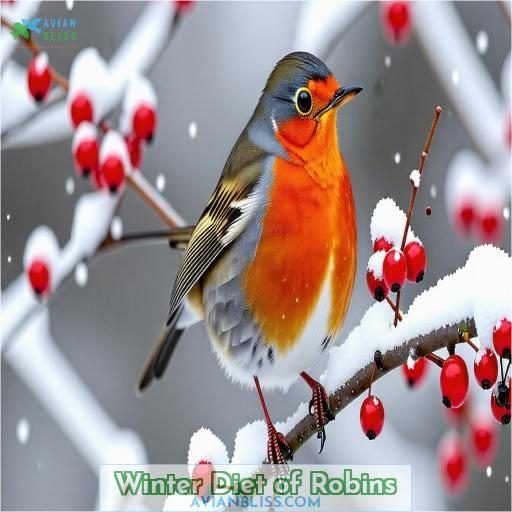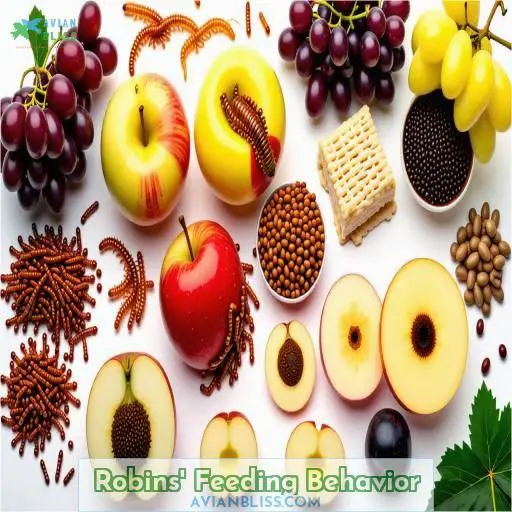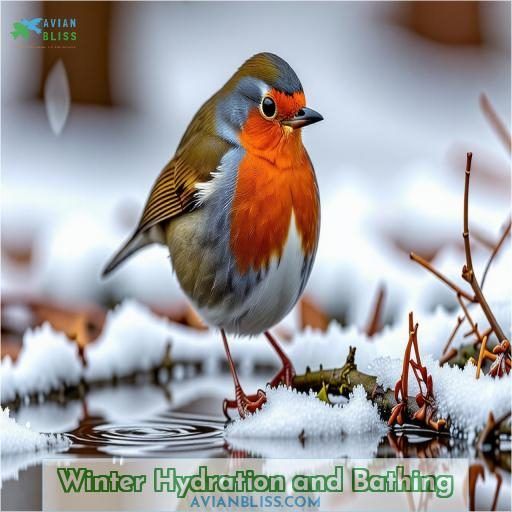This site is supported by our readers. We may earn a commission, at no cost to you, if you purchase through links.
 You might be surprised to learn that robins primarily dine on nutrient-rich fruits and berries left on shrubs, trees, and vines during the winter months.
You might be surprised to learn that robins primarily dine on nutrient-rich fruits and berries left on shrubs, trees, and vines during the winter months.
These high-calorie treats, like chokecherries and hawthorn berries, provide the essential energy they need to survive the cold.
Robins are nomadic foragers, traveling in massive flocks to feast on berries until the tree is bare before moving on.
To support these feathered friends during the harsh season, offer frozen or fresh fruit on the ground, accessible mealworms, and keep birdbaths ice-free for hydration.
Understanding their winter diet and behaviors guarantees you can properly support these feathered friends during the harsh season.
Table Of Contents
- Key Takeaways
- What Do Robins Eat in the Winter?
- Winter Diet of Robins
- Robins’ Feeding Behavior
- Survival Strategies in Cold
- Suitable Food Offerings
- Feeding Preferences
- Winter Hydration and Bathing
- Frequently Asked Questions (FAQs)
- What is the best food for robins in winter?
- What is the best food to leave out for robins?
- How do robins survive winter?
- Will robins eat from a bird feeder?
- Do robins migrate or stay in one place during winter?
- How do robins find food when the ground is frozen?
- What happens if robins dont get enough food in winter?
- Can robins eat the same foods as other backyard birds?
- Do robins need special feeders or can they use regular ones?
- Conclusion
Key Takeaways
- Robins primarily eat nutrient-rich fruits and berries left on shrubs, trees, and vines during the winter months, providing essential energy to survive the cold.
- Robins exhibit nomadic behavior in winter, traveling in massive flocks to feast on berries until the trees are bare before moving on to the next food source.
- To support robins during winter, offer frozen or fresh fruit on the ground, accessible mealworms, and keep birdbaths ice-free for hydration.
- Robins employ strategies like shivering to generate warmth and fluffing out their feathers to trap heat and insulate their bodies in cold conditions.
What Do Robins Eat in the Winter?
In the winter, robins primarily eat fruits left on shrubs and trees, as well as high-calorie berries for energy. They also supplement their diet with mealworms and shallow water for hydration, but can’t digest seeds.
Winter Diet of Robins
As winter sets in, robins heavily rely on fruits left behind on shrubs, trees, and vines as their primary food source. These high-calorie berries and fruits don’t spoil quickly in cold temperatures, making them an ideal energy source for robins during the harsh winter months.
Fruits Left on Shrubs and Trees
In winter, robins rely on the leftover fruits clinging to shrubs and trees for sustenance. These hardy birds forage for:
- Chokecherries
- Hawthorn berries
- Dogwood fruits
- Juniper berries
- Sumac drupes
Robins seek out these wild fruits, which provide essential calories to fuel their winter survival. As seasonal changes impact food availability, robins adapt their foraging strategies to thrive in their preferred habitats.
High-calorie Berries for Energy
flock size, flock behavior, flock dynamics, flock feeding patterns, flock communication,robin,winter,food,berries,energy.
Robins’ Feeding Behavior
You’ll notice robins exhibit nomadic behavior in winter, constantly moving in search of food instead of defending a home territory. These birds travel in massive flocks that may number in the thousands, feasting on fruit until the tree is bare before moving on to the next food source.
Nomadic Movement for Food
During winter, American robins exhibit nomadic movement to find food due to habitat loss and changing climates.
These birds rely on berries, worms, and fruits scattered in leaf litter.
Migration patterns may vary, with some flocks numbering in the thousands.
To support winter roosting, consider offering food sources such as mealworms and fresh fruit.
Feasting in Large Flocks
In winter, robins gather in massive flocks to feast on available fruits.
Hundreds or even thousands of birds may descend on a single tree, stripping it bare in a matter of days.
These communal feeding frenzies allow robins to make the most of limited food sources during the cold months.
Once the tree is picked clean, the flock moves on to the next berry-laden shrub or vine.
They repeat this cycle until spring arrives and worms become plentiful once more.
Survival Strategies in Cold
In frigid winter conditions, robins employ a clever strategy to maintain their body heat – they shiver, generating warmth through rapid muscle contractions. Another indispensable survival technique is fluffing out their feathers, trapping air close to their bodies to create an insulating layer that retains precious heat.
Generating Heat by Shivering
Robins generate body heat by shivering, which requires calories from food to fuel their metabolism. Sufficient food intake helps maintain their body temperature in cold weather. Offer high-calorie options like suet or grape jelly in feeders to support shivering robins. Consult the Kaufman Field Guide series for more tips on helping robins survive winter.
Importance of Fluffing Feathers Out
To conserve precious body heat, robins fluff out their feathers like tiny down jackets. This traps air close to the skin, providing insulation against the cold. Shivering burns energy, so robins minimize heat loss by fluffing up. Offer heated birdbaths to help robins stay warm and hydrated all winter long. Their survival depends on your support!
- Fl■ feathers trap heat for insulation
- Minimizes energy loss from shivering
- Heated birdbaths provide hydration and warmth
- Your backyard can be a robin’s refuge
- Support these amazing birds through winter
Suitable Food Offerings
You can provide frozen or fresh fruit on the ground as a suitable food offering for robins during winter. Mealworms, available for purchase at pet stores, are another excellent source of nutrition that robins readily consume.
Offering Frozen or Fresh Fruit
To attract robins, offer frozen or fresh fruit like apple slices, raisins, blueberries, strawberries, raspberries, or cherries on the ground. Robins prefer fruit over seed and may not visit feeders. Place offerings up high to avoid competition from other species. Provide a variety of live insects and fruit for a balanced diet.
| Fruit Preference | Frozen Fruit | Fresh Fruit |
|---|---|---|
| Robins prefer | Acceptable | Preferred |
| fruit over seed | for winter | for winter |
| and may not | feeding | feeding |
Accessibility of Mealworms
Mealworms from pet stores make an excellent supplemental food for robins in winter. Their soft beaks can easily consume these protein-rich treats. Mealworms provide essential nutrients lacking in a fruit-only diet. Offer mealworms alongside fresh fruit for a balanced avian nutrition boost. Robins will appreciate this tasty addition to their winter menu.
Feeding Preferences
You’ll want to avoid offering robins any type of seed, as their beaks aren’t designed to crack open seed hulls and they can’t digest seeds properly. Instead, provide shallow dishes of water when temperatures rise above 10°F (around -12°C); robins need access to unfrozen water sources for drinking and bathing in order to maintain their feather insulation.
Inability to Digest Seeds
Robins’ beaks aren’t built for cracking seeds, and their digestive systems can’t process them. Offer alternative food sources like mealworms, which provide essential protein. Seed-eating birds have evolved specialized beaks and digestive systems to thrive on seeds, but robins’ nutritional requirements differ. Stick to fruits, berries, and insects to keep your winter robins happy and healthy.
Providing Shallow Water for Hydration
Robins require fresh water year-round, but it’s especially critical in winter. Provide shallow water bowls, replacing the water daily to prevent freezing. Robins drink by dipping their beaks in and then raising their heads to swallow. Proper hydration helps them maintain feather insulation and survive cold temperatures. Guarantee reliable winter water sources for your feathered friends.
Winter Hydration and Bathing
Robins require accessible water sources even during winter months, as they need to drink and bathe regularly. Providing shallow dishes of fresh water, heated birdbaths, or facilitating access to unfrozen natural water sources is critical for their hydration and feather maintenance; bathing helps clean their plumage, retaining its insulating properties for warmth in cold temperatures.
Need for Water Intake
During winter, robins need water to survive.
If natural sources are frozen, they may eat snow.
It’s essential to provide shallow unfrozen water for their hydration.
To facilitate this, consider using heated birdbaths or elevated feeders.
Lack of water can lead to dirty feathers, affecting insulation.
Ensuring access to clean water helps maintain the birds’ health and overall well-being, especially in cold conditions.
Bathing for Insulation Maintenance
Robins need to bathe frequently in winter to maintain their insulation properties. Provide shallow water when temperatures are above 10°F. In extreme cold, use a heated birdbath to keep water liquid. Avoid letting steam coat feathers with ice, which prevents flight. Clean feathers trap heat better, keeping robins warm. Bathing is essential for winter survival.
Frequently Asked Questions (FAQs)
What is the best food for robins in winter?
Over 60% of robins’ winter diet is fruit. You’ll attract the most by offering sliced apples, raisins, and other fresh or frozen fruit on the ground. Mealworms are another excellent choice they love.
What is the best food to leave out for robins?
You should offer fresh or frozen fruit like berries on the ground for robins in winter. They can’t digest seeds, so mealworms from pet stores also provide essential nourishment.
How do robins survive winter?
Unlike fair-weather fowl, winter’s stark beauty beckons robins to stay—their intrepid flocks feasting on defiantly lingering fruits, generating warmth through frenetic shivering and fl■ insulation.
Will robins eat from a bird feeder?
Typically, no. Robins prefer fruits and insects over seeds, so they won’t visit traditional bird feeders. Offer frozen berries or mealworms on the ground instead.
Do robins migrate or stay in one place during winter?
While you may think robins stay put, these resourceful birds actually migrate nomadically, following food sources like berries and fruit across regions during winter’s scarce times.
How do robins find food when the ground is frozen?
When the ground freezes, you’ll find robins scratching through leaf litter for leftover fruits and berries clinging to shrubs and vines. They’ll also eat frozen fruits that have fallen from trees.
What happens if robins dont get enough food in winter?
If robins don’t get enough food, they’ll struggle to keep warm and may die from exposure to extreme cold. Their survival depends on finding sufficient high-calorie fruits and insects.
Can robins eat the same foods as other backyard birds?
No, robins can’t eat the same food as other backyard birds. They need fruits, berries, and insects – not seeds or nuts. Offering mealworms, frozen berries, and a heated birdbath will help robins survive the winter.
Do robins need special feeders or can they use regular ones?
No, you can’t use regular bird feeders for robins. They need specialized feeders designed for offering fruit, mealworms, and shallow water dishes. Their beaks aren’t suited for cracking seeds.
Conclusion
Envisioning a winter wonderland, your backyard transforms into a sanctuary for robins as they gather to seek sustenance on the frozen fruits and berries you’ve thoughtfully provided.
By understanding their dietary needs, you’ve granted these feathered nomads access to the nourishment they desire, safeguarding their survival through the harshest season.
Your dedication to their well-being not only sustains the robins but also enriches the natural tapestry surrounding your home.









